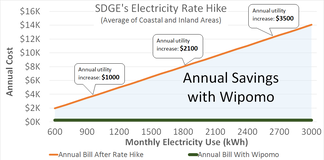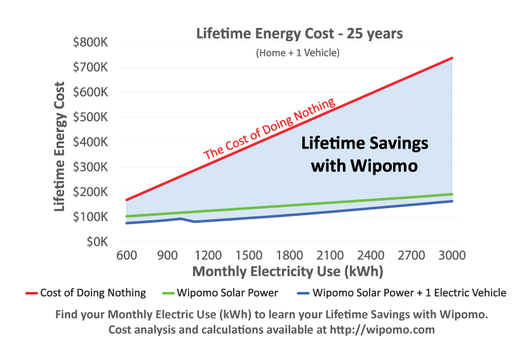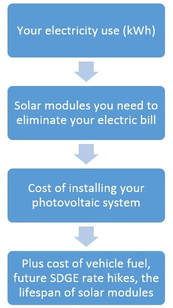
“SDGE’s Electricity Rate Hike”: How to Read It
If your home uses about 900 kWh of electricity a month (found on your electricity bill), find 900 on the horizontal axis, and then go straight up to the orange line (how much SDGE charges after the rate hike in September 2013). Your annual bill is approximately $3,000, which is close to $1000 more than before the September 2013 rate hike. Compare that to your potential electricity bill with Wipomo’s Energy Ecosystem: almost nothing every year.
SDGE’s Annual Charge to You
The annual cost of electricity from SDGE was made from SDGE’s own data posted on their website, here. We took the average cost of the Coastal and Inland areas at each monthly kWh usage (after the rate-hike) and multiplied that by 12 months. The result is the average annual cost of electricity for a given monthly electricity use.

To calculate how much SDGE raised your electricity bill, we did the same procedure with the cost of electricity before the rate hike, and then found the difference.

You can see from the graph: the more you use, the more money it costs. On the other hand, the more you use, the more Wipomo’s Energy Ecosystem can save for you. Your annual cost could be nearly $0 if you buy it upfront. You may even see that SDGE pays you if your system produces enough energy. SDGE will still charge the standard service fees for being connected to their electricity network, but on a per-year basis, a typical San Diego home (4 person household, 4 bedroom, 2 bath), could save as much as $5,000 annually, depending on their actual electricity needs. If you can’t purchase the system, it’s likely not a problem. In many cases, you can save instantly by financing the Energy Ecosystem. That means your monthly payments could be lower than your electric bill.
What about the initial cost of purchasing the energy ecosystem? See below.
Lifetime Energy Cost – 25 years: How to Read It

The lifetime saving graph captures a fuller picture that includes the cost of purchasing the energy ecosystem. And in this case, it also captures the cost of fueling 1 vehicle.
Just like in the annual graph, find how much energy you use per month on the horizontal axis. As an example, we’ll take 900 kWh again.
The red line shows how much you will likely pay SDGE for electricity in 25 years. At 900 kWh, that’s about a whopping $250,000! What could you buy with $250,000 if you could keep it? With Wipomo’s Energy Ecosystem, you can keep the lion’s share of it.
The green line shows how much you will likely pay for electricity if you buy only the Solar Photovoltaic part of the Wipomo Energy Ecosystem. At 900 kWh, the 25-year-cost comes in at a much lower $115,000, approximately. That’s almost $150,000 that you don’t have to pay SDGE.
The blue line shows you can save more if you use an electrically powered vehicle. If you break free from SDGE, you can do the same from the gas companies: power your car with your own fuel from solar photovoltaic electricity at less than 1/3rd the cost of gas.
The Cost of Doing Nothing
The Cost of Doing Nothing is calculated using Wipomo’s cost projection models. We started from the base scenario: a residential home with 1 Toyota Tundra. We used this base scenario across different amounts of energy consumption (kWh). Our model assumes that SDGE continues raising its rates at its historical level across all tiers: 6% per year. The model also calculates the annual fuel cost of a vehicle fuel rating of about 22 MPG and average annual use of 15,000 miles. The model used a flat rate cost of fuel.
Wipomo Solar Power
We’ve been developing this model for years so that we can hand over nearly instant quotes. Our model calculates exactly how much Solar Power you need (in kW and dollars) to produce any percentage of energy use for home or business. At every point along the horizontal axis, the cost of purchasing solar is in the final life-time cost.

We try to be as detailed as reasonably possible, so within the lifetime cost, we’ve added a few other figures: 1- the cost of fueling your vehicle, for comparison purpose 2- the lifespan of solar modules and 3- future SDGE rate hikes.
For point 2, solar modules actually have a very long lifespan of up to 30 years. Their efficiency does start to degrade slowly, however. So by year 25, the solar modules can produce only approximately 80% as much energy as they can in year 1. If your solar modules’ energy production falls below your consumption, you will have to pay SDGE the difference. That’s why we also include future SDGE rate hikes because you will be paying the higher rate. Still, you’re saving a lot of money and you can always add more solar modules later.
Wipomo Solar Power + 1 Electric Vehicle
Adding an electric vehicle into the mix increases your savings. In this graph, we modeled switching out an inefficient vehicle for a Super Prius: a Prius upgraded with Wipomo’s EV battery pack and plug. You can charge your vehicle with your own solar electricity. The model accounts for needing more solar modules to cover the extra electricity you need for an electrically powered vehicle. Although there is an upfront cost of purchasing a new EV or upgrading a Prius to a Super Prius, over the lifetime of the solar system and electric vehicle, you save even more money.
If you are tired of paying SDGE, tired of electric energy rate hikes and ready to see how much money and how quickly solar photovoltaics and/or electric vehicles can save for you, call, email or request a quote today. -Joseph Ocampo, Wipomo Research Intern
